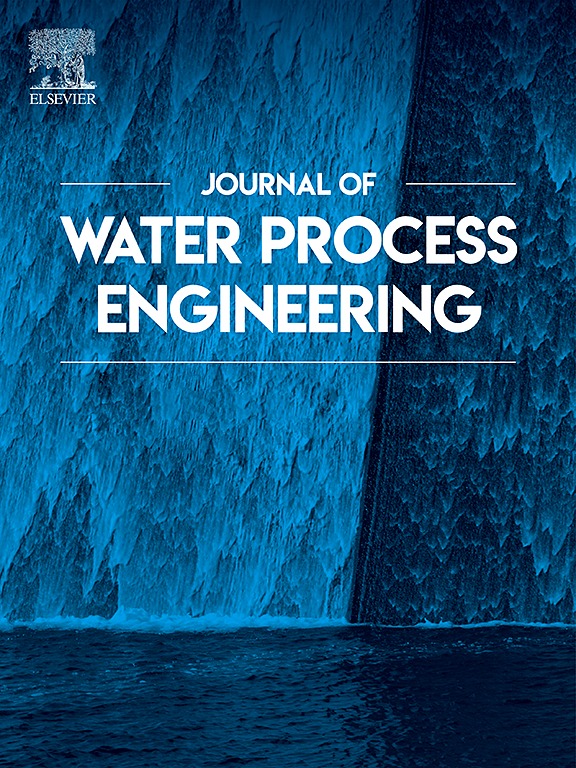Upcycling Guiera Senegalensis waste into biochar for sustainable amoxicillin removal from water
IF 6.3
2区 工程技术
Q1 ENGINEERING, CHEMICAL
引用次数: 0
Abstract
The increasing environmental pollution caused by antibiotics and solid waste presents a dual challenge. Biomass-based remediation strategies offer a promising approach to enhancing the circular economy, yet they remain a significant research challenge. In this study, a biochar with high adsorption capacity and catalytic activity was synthesized from agricultural waste (Guiera senegalensis) for the first time. The resulting biochar (GSBC) was applied in the adsorption and degradation of amoxicillin (AMX) through an advanced oxidation process (AOP) based on peroxymonosulfate (PMS) activation. The combined process (0.9 g/L GSBC/0.01 mM PMS) achieved AMX degradation rates of approximately 95.0 % and 90.0 % within 45 min in distilled and river water, respectively. Mechanistic studies using radical scavengers revealed that AMX removal occurred via both radical (HO•, SO4• –and O2• –) and non-radical (1O2) pathway. The influence of inorganic salts (Cl−, NO3−, CO32−, SO42−and PO43−) was also evaluated, with SO42−and PO43− exerting the greatest inhibitory effects; however, removal efficiency remained around 80 % despite their presence. The GSBC/PMS system was further tested in various real water matrices, including river water, fountain tower water, aquaculture facility water, and tap water, demonstrating comparable efficiency to that observed in pure water, particularly in river water. Phytotoxicity assessments in different matrices also indicated better performance in river water. This study introduces a novel biochar precursor, promotes agricultural waste valorization, and contributes to the development of sustainable wastewater treatment within the framework of the circular economy.

将塞内加尔吉尔拉(Guiera Senegalensis)废物转化为生物炭,以可持续方式去除水中的阿莫西林
本文章由计算机程序翻译,如有差异,请以英文原文为准。
求助全文
约1分钟内获得全文
求助全文
来源期刊

Journal of water process engineering
Biochemistry, Genetics and Molecular Biology-Biotechnology
CiteScore
10.70
自引率
8.60%
发文量
846
审稿时长
24 days
期刊介绍:
The Journal of Water Process Engineering aims to publish refereed, high-quality research papers with significant novelty and impact in all areas of the engineering of water and wastewater processing . Papers on advanced and novel treatment processes and technologies are particularly welcome. The Journal considers papers in areas such as nanotechnology and biotechnology applications in water, novel oxidation and separation processes, membrane processes (except those for desalination) , catalytic processes for the removal of water contaminants, sustainable processes, water reuse and recycling, water use and wastewater minimization, integrated/hybrid technology, process modeling of water treatment and novel treatment processes. Submissions on the subject of adsorbents, including standard measurements of adsorption kinetics and equilibrium will only be considered if there is a genuine case for novelty and contribution, for example highly novel, sustainable adsorbents and their use: papers on activated carbon-type materials derived from natural matter, or surfactant-modified clays and related minerals, would not fulfil this criterion. The Journal particularly welcomes contributions involving environmentally, economically and socially sustainable technology for water treatment, including those which are energy-efficient, with minimal or no chemical consumption, and capable of water recycling and reuse that minimizes the direct disposal of wastewater to the aquatic environment. Papers that describe novel ideas for solving issues related to water quality and availability are also welcome, as are those that show the transfer of techniques from other disciplines. The Journal will consider papers dealing with processes for various water matrices including drinking water (except desalination), domestic, urban and industrial wastewaters, in addition to their residues. It is expected that the journal will be of particular relevance to chemical and process engineers working in the field. The Journal welcomes Full Text papers, Short Communications, State-of-the-Art Reviews and Letters to Editors and Case Studies
 求助内容:
求助内容: 应助结果提醒方式:
应助结果提醒方式:


